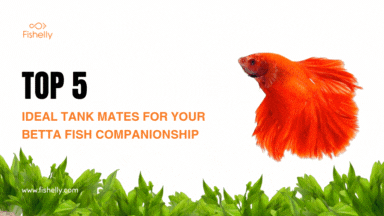Top 5 Ideal Tank Mates for Your Betta Fish Companionship
Discover the top five compatible tank mates for your betta fish. Learn how these species can coexist peacefully and enhance the vibrancy of your aquarium.
Table of Contents
Corydoras Catfish
Corydoras catfish are small, peaceful bottom-swimmers and spend most of their time swimming along the bottom of an aquarium. Social fish, it would be best to keep them in groups of six or more. Therefore, Corydoras catfish are actually quite docile creatures and, therefore, can make a good companion for a betta.
Cleaning Crew: Corydoras dig out any leftover food falling to the bottom thus keeping a clean substrate. This is not only a sure fire way of keeping the aquarium tidy, but also means that there will be minimal waste in the water thus maintaining optimal water quality.
Social Animals: Their friendly nature stimulates them to intermingle with each other, thus increasing the liveliness of the aquarium. Aquarists would often enjoy watching their swim and play around.
Tank size: At least 20 gallons, but as needed according to sufficient room for the betta and small school of corydoras to swim about.
Substrate Preference: A sand or smooth gravel substrate will help protect the sensitive barbels of your fish.
Neon Tetras
Neon tetras are schooling fish which are relatively small, colorful, and of peaceful character. It absolutely requires a minimum of six; it's not only for their comfort but to add a lovely splash of colors in your aquarium. Their non-aggressive nature makes them an excellent choice for keeping with a male betta if introduced properly.
Benefits:
Non-Aggressive : Neon tetras are small and fast swimming, helping them avoid the territorial aggression of bettas. Their speed and agility often keep them out of aggressive encounters.
Swimming Behavior: That natural tendency to swim in schools makes for quite a lively and interesting environment as they dart about in sync. This behavior can lend movement and life to your tank.
Care Tips:
Water Parameters: Neon tetras prefer slightly acidic to neutral water pH 6.0-7.0 and a temperature of 70-81°F. Stability of water parameters is the priority.
Diet: Feed high-quality flake foods supplemented with live or frozen fare such as brine shrimp or daphnia periodically to add some variation.
Ghost Shrimp
Ghost shrimp are interesting, pretty hardy invertebrates that can be kept peacefully with bettas. They swim around the bottom of the tank, creating quite a display in their transparent bodies. Having clean-up animals present and consuming all organic waste helps to maintain the health and cleanliness of the tank in general.
Advantages
Ghost Shrimp for Organic Cleaners: Because ghost shrimp can survive on algae and leftover food well, a clean environment will be created inside the tank. So, the changes on the water have to be made less often.
Low Conflicts: Ghost shrimp are not natural bettas. They just lie on the substrate and hide in most of their times. Given such a characteristic, they will not cause betta aggression, which will be great companions for them.
Tank Conditions: Ensure sufficient shelter with live plants or ornaments that prevent competition between the ghost shrimp and the betta.
Diet: Feed ghost shrimp with algae wafers of good quality, sinking pellets or blanched zucchini and spinach.
Harlequin Rasboras
The Harlequin Rasboras are small peaceful fish, which grow nicely in schools of six or more. These Rasboras are great little swimmers with really good colors. They are extremely popular to use in community tanks. Their swimming behavior allows them to spend most their time in the middle and top areas of the tank, which will allow a Betta to be able to express its dominance over territory.
This will also help the plants grow as the Rasboras don't just hang around at the bottom of the tank.
Pros:
Docile Nature: They are docile fish. They seem to do little other than swim about in their community, and they appear to be content working with other Rasboras. In all, their docile nature makes them prime additions to just about any community tank.
Vibrant Colors: The bright orange and black coloring will really pop against the drabness of their background and really stand out amidst the other colors of your betta.
Care:
Water Parameters: Harlequin rasboras live well in slightly acidic to neutral water. Their optimal range by where they perform the best is between pH 6.0-7.5. Their preferable temperature range should be between 75-82°F. Monitoring of the water condition is also very essential to keep them healthy.
Diet: Give them a good mixture of flake, pellet, and live or frozen foods for them to be healthy and alert.
African Dwarf Frogs
These are small, aquatic frogs that can be used as quite an interesting aquarium tank mate for your betta. These are peaceful natured and get mostly active at night; thus, a reduction in competition by them in the daytime. The interesting swimming style adds another layer of interest to your aquarium.
Benefits:
Non-Competitors: African dwarf frogs typically occupy the lower to middle portions of the tank so minimize head-to-head competition with bettas over territory and resources.
Interesting Interactions: Their funny antics and frolicking in water can be really entertaining and add flavor to your aquarium.
Care:
Tank Environment: It needs to have many hiding places and lots of decorations for the frogs to inspect. The lid on the tank should be secure since the frogs can jump.
Feeding: Feed them on some high-quality frog pellets, bloodworms, and brine shrimp. They should be fed without competition that may come from the betta.
Faq
1.What are the best tank mates for betta fish?
Corydoras catfish, neon tetras, ghost shrimp, harlequin rasboras, and African dwarf frogs.
2.Can betta fish live with neon tetras?
Yes, if introduced properly. Their speed helps avoid aggression.
3.Are ghost shrimp good companions for bettas?
Yes, they are hardy and usually stay hidden, minimizing conflicts.
4.How many Corydoras catfish should I keep with my betta?
At least six in a group for social behavior.
5.What are the care requirements for harlequin rasboras?
Prefer pH 6.0-7.5 and temperatures of 75-82°F; feed a varied diet.
6.Do African dwarf frogs compete with bettas for food?
Minimal competition; feed them separately to ensure they get enough.
7.What tank size is suitable for a betta with tank mates?
A minimum of 20 gallons is recommended.
8.Can I keep multiple bettas together with these tank mates?
No, male bettas can be aggressive toward each other. Female bettas can coexist in a sorority with careful monitoring.
Conclusion
Thus, the space becomes even more beautiful and pleasing by adding some well-chosen tank mates. Some of the recommended species are Corydoras catfish, neon tetras, ghost shrimp, harlequin rasboras, or even African dwarf frogs. Proper care and observation ensure that this is really a living, breathing display of unique features for the residents of your aquarium. Happy fishkeeping!















